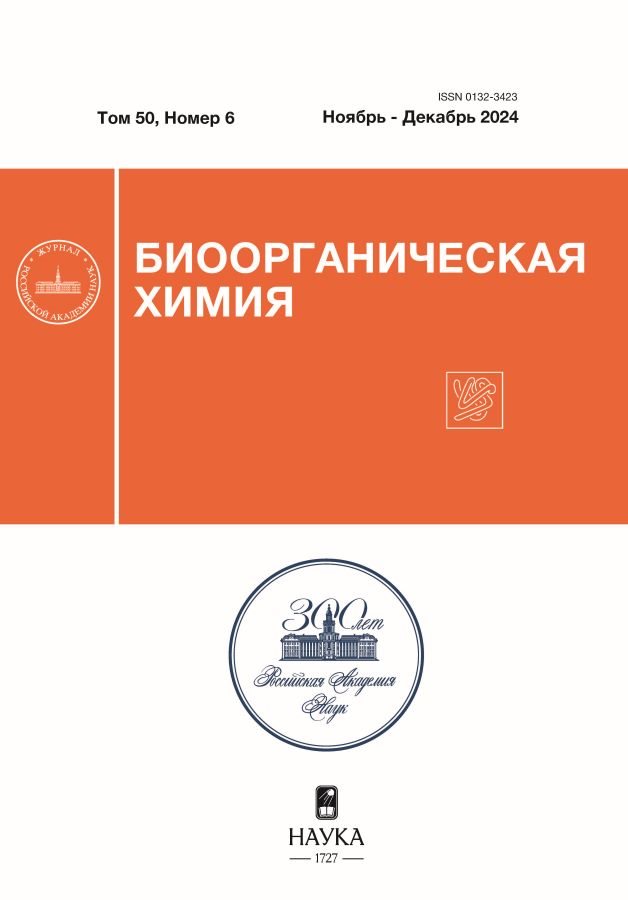Structural analysis of LZTFL1 protein by the principal component analysis method (PCA-seq)
- Authors: Khegay I.I.1, Yu X.2, Efremov V.M.1,2
-
Affiliations:
- Federal Research Center Institute of Cytology and Genetics, Siberian Branch, RAS
- Novosibirsk State University
- Issue: Vol 50, No 6 (2024)
- Pages: 806-812
- Section: Articles
- URL: https://archivog.com/0132-3423/article/view/670755
- DOI: https://doi.org/10.31857/S0132342324060075
- EDN: https://elibrary.ru/NFJQUO
- ID: 670755
Cite item
Abstract
The single-nucleotide mutation rs17713054G>A in the promoter region of LZTFL1 (leucine zipper transcription factor like 1) gene is a factor in the severe course of coronavirus infection COVID-19. Computer statistical analysis of the gene by principal component analysis (PCA-seq) revealed the presence of a high correlation between the first principal component of the translated amino acid sequence and eleven amino acid indices of the AAindex database, characterizing the physicochemical and biochemical properties of the protein. The indices BEGF750102, CHOP780209, PALJ810110, GEIM800107, QIAN880121, LEVM780102, PRAM900103 are associated with β-folding parameters. The LZTFL1 protein is part of the Bardet-Biedl Syndrome (BBS) protein complexes that regulate intracellular transport in the ciliated epithelium of the lungs. It is assumed that the presence of β-sheet elements in the structure of the LZTFL1 protein plays an important role in ACE2 receptor-mediated endocytosis, stimulating the rate of angiotensin-converting enzyme 2 recycling and accelerating the delivery of adherented coronavirus SARS-CoV-2 virions into the cell during the initiation of severe acute respiratory syndrome COVID-19.
Full Text
About the authors
I. I. Khegay
Federal Research Center Institute of Cytology and Genetics, Siberian Branch, RAS
Author for correspondence.
Email: khegay@bionet.nsc.ru
Russian Federation, prosp. Akad. Lavrentieva 10, Novosibirsk, 630090
X. Yu
Novosibirsk State University
Email: khegay@bionet.nsc.ru
Russian Federation, ul. Pirogova 2, Novosibirsk, 630090
V. M. Efremov
Federal Research Center Institute of Cytology and Genetics, Siberian Branch, RAS; Novosibirsk State University
Email: khegay@bionet.nsc.ru
Russian Federation, prosp. Akad. Lavrentieva 10, Novosibirsk, 630090; ul. Pirogova 2, Novosibirsk, 630090
References
- Seo S., Zhang Q., Bugge K., Breslow D.K., Searby C.C., Nachury M.V., Sheffield V.C. // PLoS Genet. 2011. V. 7. P. e1002358. https://doi.org/10.1371/journal.pgen.1002358
- Huang Q., Li W., Zhou Q., Awasthi P., Cazin C., Yap Y., Mladenovic-Lucas L., Hu B., Jeyasuria P., Zhang L., Granneman J.G., Hess R.A., Ray P.F., Kherraf Z.-E., Natarajan V., Zhang Z. // Dev. Biol. 2021. V. 477. P. 164–176. https://doi.org/10.1016/j.ydbio.2021.05.006
- Fliegauf M., Benzing T., Omran H. // Nat. Rev. Mol. Cell Biol. 2007. V. 8. P. 880–893. https://doi.org/10.1038/nrm2278
- Lyu Q., Li Q., Zhou J., Zhao H. // J. Cell Biol. 2024. V. 223. P. e202307150. https://doi.org/10.1083/jcb.202307150
- Downes D.J., Cross A.R., Hua P., Roberts N., Schwessinger R., Cutler A.J., Munis A.M., Brown J., Mielczarek O., de Andrea C.E., Melero I., COMBAT Consortium, Gill D.R., Hyde S.C., Knight J.C., Todd J.A., Sansom S.N., Issa F., Davies J.O.J., Hughes J.R. // Nat. Genet. 2021. V. 53. P. 1606–1615. https://doi.org/10.1038/s41588-021-00955-3
- Anderson R.M., Heesterbeek H., Klinkenberg D., Déirdre Hollingsworth T.D. // Lancet. 2020. V. 395. P. 931–934. https://doi.org/10.1016/S0140-6736(20)30567-5
- Tang X., Wu C., Li X., Song Y., Yao X., Wu X., Duan Y., Zhang H., Wang Y., Qian Z., Cui J., Lu J. // Natl. Sci. Rev. 2020. V. 7. P. 1012–1023. https://doi.org/10.1093/nsr/nwaa036
- Hu B., Guo H., Zhou P., Shi Z.-L. // Nat. Rev. Microbiol. 2021. V. 19. P. 141–154. https://doi.org/10.1038/s41579-020-00459-7
- Lu J., Sun P.D. // J. Biol. Chem. 2020. V. 295. P. 18579– 18588. https://doi.org/10.1074/jbc.RA120.015303
- Lan J., Ge J., Yu J., Shan S., Zhou H., Fan S., Zhang Q., Shi X., Wang Q., Zhang L., Wang X. // Nature. 2020. V. 581. P. 215–220. https://doi.org/10.1038/s41586-020-2180-5
- Hajizadeh F., Khanizadeh S., Khodadadi H., Mokhayeri Y., Ajorloo M., Malekshahi A., Heydaria E. // Microb. Pathog. 2022. V. 168. P. 105595. https://doi.org/10.1016/j.micpath.2022.105595
- Wysocki J., Schulze A., Batlle D. // Biomolecules. 2019. V. 9. P. 886. https://doi.org/10.3390/biom9120886
- Lu J., Sun P.D. // J. Biol. Chem. 2020. V. 295. P. 18579– 18588. https://doi.org/10.1074/jbc.RA120.015303
- Guy J.L., Lambert D.W., Warner F.J., Hooper N.M., Turner A.J. // Biochim. Biophys. Acta. 2005. V. 1751. P. 2–8. https://doi.org/10.1016/j.bbapap.2004.10.010
- Iwasaki M., Saito J., Zhao H., Sakamoto A., Hirota K., Ma D. // Inflammation. 2021. V. 44. P. 13–34. https://doi.org/10.1007/s10753-020-01337-3
- Ren Y., Lv L., Li P., Zhang L. // J. Infect. 2022. V. 85. P. e21–e23. https://doi.org/10.1016/j.jinf.2022.04.019
- Klink B.U., Gatsogiannis C., Hofnagel O., Wittinghofer A., Raunser S. // eLife. 2020. V. 9. P. e53910. https://doi.org/10.7554/eLife.53910
- Muller J., Stoetzel C., Vincent M.C., Leitch C.C., Laurier V., Danse J.M., Hellé S., Marion V., Bennouna-Greene V., Vicaire S., Megarbane A., Kaplan J., Drouin-Garraud V., Hamdani M., Sigaudy S., Francannet C., Roume J., Bitoun P., Goldenberg A., Philip N., Odent S., Green J., Cossée M., Davis E.E., Katsanis N., Bonneau D., Verloes A., Poch O., Mandel J.L., Dollfus H. // Hum. Genet. 2010. V. 127. P. 583–593. https://doi.org/10.1007/s00439-010-0804-9
- Liu P., Lechtreck K.F. // Proc. Natl. Acad. Sci. USA. 2018. V. 115. P. E934–E943. https://doi.org/10.1073/pnas.1713226115
- Jin H., White S.R., Shida T., Schulz S., Aguiar M., Gygi S.P., Bazan J.F., Nachury M.V. // Cell. 2010. V. 141. P. 1208–1219. https://doi.org/10.1016/j.cell.2010.05.015
- Pereira J., Lupas A.N. // Front. Mol. Biosci. 2022. V. 9. P. 895496. https://doi.org/10.3389/fmolb.2022.895496.
- Ефимов В.М., Ефимов К.В., Ковалева В.Ю. // Вавиловский журнал генетики и селекции. 2019. Т. 23. С. 1032–1036. https://doi.org/10.18699/VJ19.584
- Takens F. // Dynamical Systems and Turbulence, Lecture Notes in Mathematics. 1981. V. 898. P. 366– 381. https://doi.org/10.1007/BFb0091924
- Gower J.C. // Biometrika. 1966. V. 53. P. 325–338. https://doi.org/10.1093/biomet/53.3-4.325
- Cavalli-Sforza L.L., Menozzi P., Piazza A. // J. Asian Studies. 1995. V. 54. P. 2173–2219. https://doi.org/10.2307/2058750
- Kawashima S., Pokarowski P., Pokarowska M., Kolinski A., Katayama T., Kanehisa M. // Nucleic Acids Res. 2008. V. 36. P. D202–D205. https://doi.org/10.1093/nar/gkm998
- Benjamini Y., Hochberg Y. // J. R. Statist. Soc. B. 1995. V. 57. P. 289–300. https://doi.org/10.1111/j.2517-6161.1995.tb02031.x
- Hammer Ø., Harper D.A., Ryan P.D. // Palaeontologia Electronica. 2001. V. 4. P. 1–9. https://palaeo-electronica.org/2001_1/past/issue1_01.htm
- Polunin D., Shtaiger I., Efimov V. // bioRxiv. 2019. P. 803684. https://doi.org/10.1101/803684
Supplementary files











